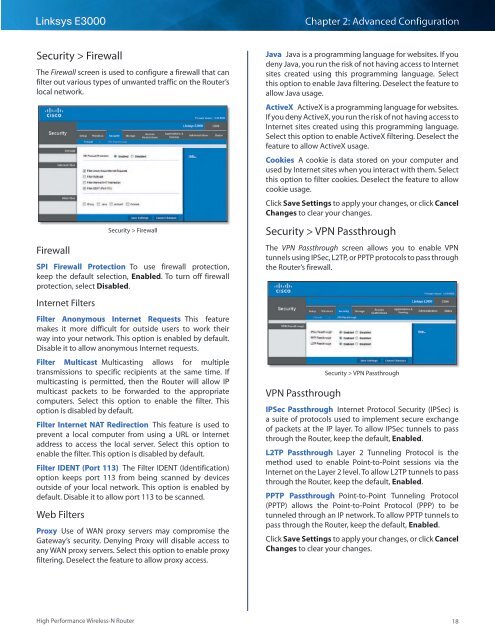You also want an ePaper? Increase the reach of your titles
YUMPU automatically turns print PDFs into web optimized ePapers that Google loves.
Linksys <strong>E3000</strong><br />
Chapter 2: Advanced Configuration<br />
Security > Firewall<br />
The Firewall screen is used to configure a firewall that can<br />
filter out various types of unwanted traffic on the Router’s<br />
local network.<br />
Firewall<br />
Security > Firewall<br />
SPI Firewall Protection To use firewall protection,<br />
keep the default selection, Enabled. To turn off firewall<br />
protection, select Disabled.<br />
Internet Filters<br />
Filter Anonymous Internet Requests This feature<br />
makes it more difficult for outside users to work their<br />
way into your network. This option is enabled by default.<br />
Disable it to allow anonymous Internet requests.<br />
Filter Multicast Multicasting allows for multiple<br />
transmissions to specific recipients at the same time. If<br />
multicasting is permitted, then the Router will allow IP<br />
multicast packets to be forwarded to the appropriate<br />
computers. Select this option to enable the filter. This<br />
option is disabled by default.<br />
Filter Internet NAT Redirection This feature is used to<br />
prevent a local computer from using a URL or Internet<br />
address to access the local server. Select this option to<br />
enable the filter. This option is disabled by default.<br />
Filter IDENT (Port 113) The Filter IDENT (Identification)<br />
option keeps port 113 from being scanned by devices<br />
outside of your local network. This option is enabled by<br />
default. Disable it to allow port 113 to be scanned.<br />
Web Filters<br />
Proxy Use of WAN proxy servers may compromise the<br />
Gateway’s security. Denying Proxy will disable access to<br />
any WAN proxy servers. Select this option to enable proxy<br />
filtering. Deselect the feature to allow proxy access.<br />
Java Java is a programming language for websites. If you<br />
deny Java, you run the risk of not having access to Internet<br />
sites created using this programming language. Select<br />
this option to enable Java filtering. Deselect the feature to<br />
allow Java usage.<br />
ActiveX ActiveX is a programming language for websites.<br />
If you deny ActiveX, you run the risk of not having access to<br />
Internet sites created using this programming language.<br />
Select this option to enable ActiveX filtering. Deselect the<br />
feature to allow ActiveX usage.<br />
Cookies A cookie is data stored on your computer and<br />
used by Internet sites when you interact with them. Select<br />
this option to filter cookies. Deselect the feature to allow<br />
cookie usage.<br />
Click Save Settings to apply your changes, or click Cancel<br />
Changes to clear your changes.<br />
Security > VPN Passthrough<br />
The VPN Passthrough screen allows you to enable VPN<br />
tunnels using IPSec, L2TP, or PPTP protocols to pass through<br />
the Router’s firewall.<br />
VPN Passthrough<br />
Security > VPN Passthrough<br />
IPSec Passthrough Internet Protocol Security (IPSec) is<br />
a suite of protocols used to implement secure exchange<br />
of packets at the IP layer. To allow IPSec tunnels to pass<br />
through the Router, keep the default, Enabled.<br />
L2TP Passthrough Layer 2 Tunneling Protocol is the<br />
method used to enable Point-to-Point sessions via the<br />
Internet on the Layer 2 level. To allow L2TP tunnels to pass<br />
through the Router, keep the default, Enabled.<br />
PPTP Passthrough Point-to-Point Tunneling Protocol<br />
(PPTP) allows the Point-to-Point Protocol (PPP) to be<br />
tunneled through an IP network. To allow PPTP tunnels to<br />
pass through the Router, keep the default, Enabled.<br />
Click Save Settings to apply your changes, or click Cancel<br />
Changes to clear your changes.<br />
High Performance Wireless-N Router<br />
18


